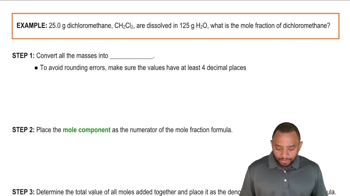Here are the essential concepts you must grasp in order to answer the question correctly.
Osmotic Pressure
Osmotic pressure is the pressure required to prevent the flow of solvent into a solution through a semipermeable membrane. It is directly proportional to the concentration of solute particles in the solution, as described by the van 't Hoff equation: π = iCRT, where π is osmotic pressure, i is the van 't Hoff factor, C is molarity, R is the ideal gas constant, and T is temperature in Kelvin.
Recommended video:
Molar Mass and Moles
Molar mass is the mass of one mole of a substance, typically expressed in grams per mole (g/mol). To find the number of moles of a substance in a mixture, the mass of the substance is divided by its molar mass. This concept is essential for calculating concentrations and relating mass to osmotic pressure in solutions.
Recommended video:
Mass Fraction
Mass fraction is a way of expressing the concentration of a component in a mixture, defined as the mass of the component divided by the total mass of the mixture. In this problem, determining the mass fraction of sucrose (Xsucrose) involves calculating the proportion of sucrose's mass relative to the total mass of the sugar mixture, which is crucial for solving for its contribution to the osmotic pressure.
Recommended video:




